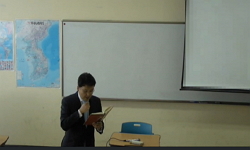오늘날과 같이 급변하는 시대에 요구되는 창의․인성 역량을 강화하기 위한 교육으로서 박물관의 교육기능이 주목받고 있다. 이는 박물관 교육이 전시물을 기반학습으로 학습자에게 자...
http://chineseinput.net/에서 pinyin(병음)방식으로 중국어를 변환할 수 있습니다.
변환된 중국어를 복사하여 사용하시면 됩니다.
- 中文 을 입력하시려면 zhongwen을 입력하시고 space를누르시면됩니다.
- 北京 을 입력하시려면 beijing을 입력하시고 space를 누르시면 됩니다.
전시물 기반 학습을 통한 박물관 교육 프로그램 개발 사례 연구 -대한민국역사박물관 ‘하이! 보빙사’를 중심으로- = A Case Study on The Development of Museum Education Program through Object-Based Learning - Focused on ‘Hi! Bobingsa’ at the National Museum of Korean Contemporary History-
한글로보기https://www.riss.kr/link?id=A105455010
- 저자
- 발행기관
- 학술지명
- 권호사항
-
발행연도
2017
-
작성언어
-
-
주제어
박물관 교육 ; 전시물 기반 학습 ; 구성주의 ; 보조 전시물 ; 보빙사 ; museum education ; object-based learning ; constructivism ; bobingsa
-
KDC
370
-
자료형태
학술저널
-
수록면
37-57(21쪽)
- 제공처
-
0
상세조회 -
0
다운로드
부가정보
국문 초록 (Abstract)
오늘날과 같이 급변하는 시대에 요구되는 창의․인성 역량을 강화하기 위한 교육으로서 박물관의 교육기능이 주목받고 있다. 이는 박물관 교육이 전시물을 기반학습으로 학습자에게 자기주도학습, 탐구학습, 맥락학습, 협동학습 등을 경험할 수 있는 구성주의 학습 기회를 부여하기 때문이다. 한편 전시물을 기반 학습에서 전시물은 주제와의 연관성 및 활용 범위에 따라 1차적 핵심 전시물(primary core objects), 2차적 부차 전시물(secondary sub objects), 3차적 보조 전시물(third supplementary objects)로 나뉘며 전시물에 대한 학습(learning about object)과 전시물을 통한 학습(learning with/through object)에 두루 활용된다. 이에 본 연구에서는 조선 최초의 대미사절단인 보빙사와 연관된 대한민국역사박물관의 전시물을 활용한 <HI(하이)! 보빙사> 프로그램 개발 방안을 전시물 기반 학습의 사례로 살펴보았다. 본 프로그램은 1차적 및 2차적 전시물이 부족한 상황에서 3차적 보조 전시물을 충분히 활용하여 전시물 기반 학습을 구현한 사례라는 점에서 그 의의를 찾을 수 있다.
다국어 초록 (Multilingual Abstract)
Museum education function is drawing attention for strengthening the capacity of creativity and character in today’s fast-changing world. This is because museum education provides opportunities of constructivism learning that features Self-Directed ...
Museum education function is drawing attention for strengthening the capacity of creativity and character in today’s fast-changing world. This is because museum education provides opportunities of constructivism learning that features Self-Directed Learning, Inquiry-based Learning, Contextual Learning, Cooperative learning by offering diverse learning experience through object-based learning. Meanwhile Objects in object-based learning are categorized into three groups such as primary core objects, secondary sub objects and third supplementary objects according to relationship to education’s subject and scope of object’s usage. There is wide use of these objects for learning about object and learning with/through object. Accordingly, this study looked into the <HI! Bobingsa> program development process using
National Museum of Korean Contemporary History’s objects related to the first diplomatic group towards America in Joseon Dynasty. This study can find its meaning in suggesting example of education program using third supplementary objects with lack of primary core objects, secondary sub objects.
목차 (Table of Contents)
- Ⅰ. 들어가는 말
- Ⅱ. 이론적 배경
- Ⅲ. 전시물 기반 학습을 통한 교육 프로그램 개발
- Ⅳ. 나가는 말
- Ⅰ. 들어가는 말
- Ⅱ. 이론적 배경
- Ⅲ. 전시물 기반 학습을 통한 교육 프로그램 개발
- Ⅳ. 나가는 말
동일학술지(권/호) 다른 논문
-
- 한국박물관교육학회
- 오명숙
- 2017
-
- 한국박물관교육학회
- 권남희
- 2017
-
- 한국박물관교육학회
- 윤소정
- 2017
-
박물관 모바일 교육 프로그램에 나타난 맥락적 학습모형(Contextual Model of Learning)의 요소 분석 -대한민국역사박물관 어린이체험전시실 사례를 중심으로-
- 한국박물관교육학회
- 민성훈
- 2017




 스콜라
스콜라






